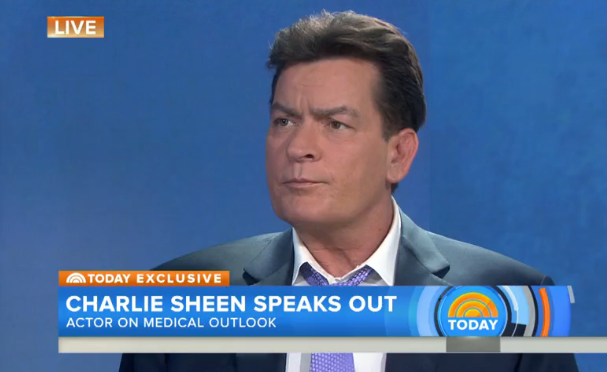Charlie Sheen Says It Is 'Impossible' For Him To Transmit His HIV Through Unprotected Sex, But What Does That Actually Mean?

Unprotected sex with an HIV-positive person is a risky endeavor. Research has shown that transmission of the virus happens once every 900 times a heterosexual HIV-positive person has unprotected sex — though the risk is much higher for men who have sex with men. Yet on Tuesday, when Charlie Sheen announced on Today that he is HIV-positive, he also said he’s still having unprotected sex under a doctor’s supervision. What exactly does he mean?
Sheen told Today host Matt Lauer that despite his HIV diagnosis, he’s still having unprotected sex. He said he’s doing so under the supervision of his doctor, Dr. Robert Huizenga, an assistant professor of clinical medicine at UCLA. He said it’s “impossible” for him to transmit the HIV virus to any of his present or future sexual partners because he has an undetectable amount of the disease in his blood.
HIV is a relentless disease that attacks the immune system, specifically T helper cells, which regulate immune responses. The viral cells then replicate within these T helper cells and eventually kill them. As a result, the infected person becomes less able to fight off common infections and other diseases. Left untreated, HIV can become AIDS, a more serious and deadly disease. Although there are other ways to transmit HIV, the most common is through unprotected vaginal or anal sex with an infected person, which is why it’s peculiar Sheen would claim his sexual partners are safe.
However, Huizenga clarified the risk by saying, "Individuals who are optimally treated, who have undetectable viral loads [the number of HIV virus cells in a milliliter of blood], who responsibly use protection — it's incredibly low. It's incredibly rare to transmit the virus. We can't say that that's zero, but it's a very, very low number."
Huizenga said that when Sheen found out he had the virus four years ago, he was immediately put on a regimen of strong antiretroviral drugs, which have helped to reduce his viral load. "Unfortunately we don't have a cure yet, but it's suppressed the virus to the point that he is absolutely healthy from that vantage," he said.
For those in a “mixed-status” relationship — couples comprised of only one partner who is HIV-positive — antiretroviral therapy (ART) is crucial to preventing transmission. However, a recent, three-year-long study found encouraging evidence of HIV prevention with the use of preexposure prophylaxis (PrEP), which is meant for healthy partners of those with HIV. For 48 weeks, the study followed HIV-negative men who had sex with men to determine how the treatment affected the group, which is considered most at risk of HIV. It found those who remained on PrEP had a relatively low HIV infection rate; only two of the 437 participants acquired the virus over the course of the trial.
For mixed-status relationships, the risk of transmission is a constant reality. But there are many ways to maximize prevention, including ART and PrEP, as well as using the time-tested condom. Choosing to partake in less risky sexual behaviors in general may also reduce risk of infection. If you feel like you’ve been infected, talk to your doctor immediately and get tested for any sexually transmitted diseases.



























